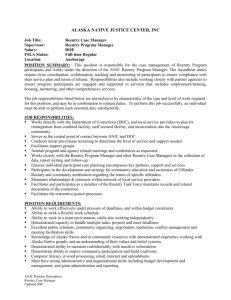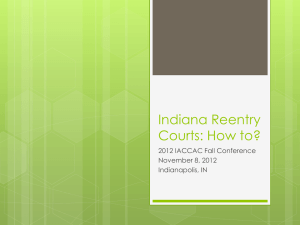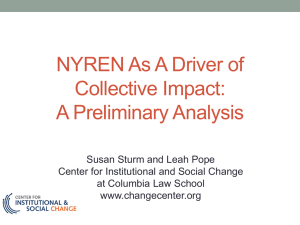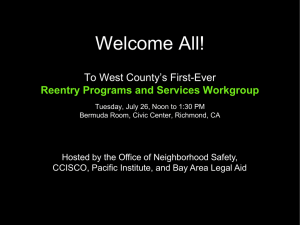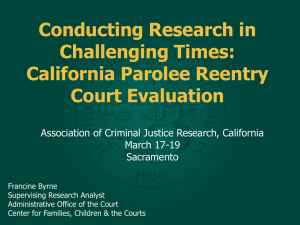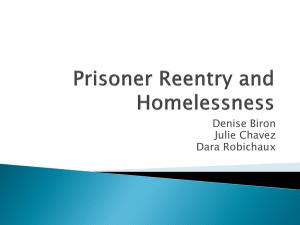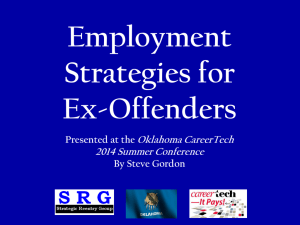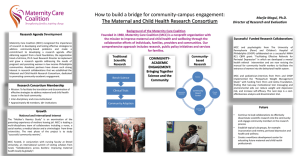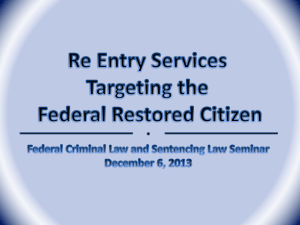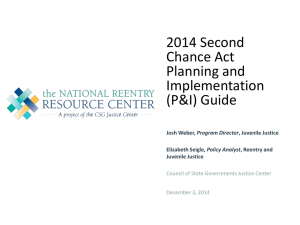Miller 251013 - Offender Supervision in Europe
advertisement
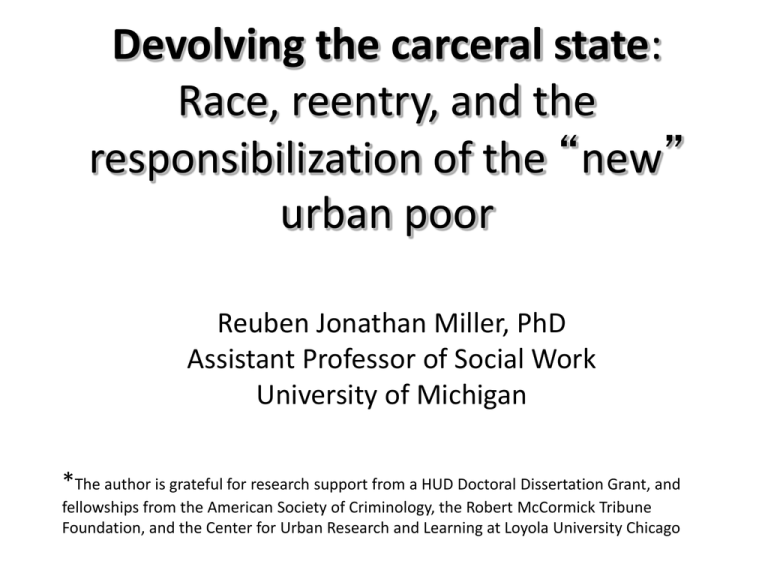
Devolving the carceral state: Race, reentry, and the responsibilization of the “new” urban poor Reuben Jonathan Miller, PhD Assistant Professor of Social Work University of Michigan *The author is grateful for research support from a HUD Doctoral Dissertation Grant, and fellowships from the American Society of Criminology, the Robert McCormick Tribune Foundation, and the Center for Urban Research and Learning at Loyola University Chicago The Second Chance Act of 2007 (SCA) • Reinvigorated the place of rehabilitation in criminal justice • Legitimized risk reduction through personal transformation as appropriate social policy intervention for the underclass • Renewed commitment to the redemptive capacities of self reliance and personal accountability Second Chance Act Appropriations • $165 million for – Vocational training and Workforce Development – Commitment to reduce recidivism by 50% • The “text” of SCA speaks to risk reduction – But… the devil is in the empirical details • Funding appropriated for: – Surveillance • Court Monitoring and Parole enforcement – Mentorship programs – WORKFORCE PREPERATION SERVICES Prisoner Reentry and U.S. Poverty Policy • Exhibits Enduring Collusion between welfare state and criminal justice actors to manage marginality (Garland 1985; Beckett and Western 2001) • Demonstrates the reconfiguration and considerable expansion of the state (Wacquant, 2012) • Not at all about risk reduction, but the transformation of the ex-offender into a “productive citizen” (Foucault, 1977; Hasenfeld, 1972) CARCERAL DEVOLUTION A Double Movement Occurring across Geographic and Conceptual Domains Geographically From Prisons (central/public sector) to Communities (local authority/government and third sector) Why this is not simply “Privitization” Shifting Ideological/Conceptual Terrain From ex-convict social ecology (community risk) to interiority of the ex-offender (Psychologies, spiritualties, rationalities, and mentalities of ex-offenders) Brief Literature Review • 1870 Declaration of Principles • Rehabilitation built around moral suasion through personal transformation via religion and work (Foucault 1977; Simon 1993) • “Penal Welfarism” modus operandi of Corrections for nearly a century (Garland 2001) Ending Welfare (and rehabilitation) as we knew it • The assault on prisoner rehabilitation occurred alongside an assault on public welfare – – – – – What works (Martinson 1974) Broken Windows (Wilson and Kelley 1982), Losing Ground (Murray 1985) Crime and Human Nature (Hernstein and Wilson 1985) The Bell Curve (Hernstein and Murray 1994) • Initiating a punitive turn in criminal justice and social welfare policy • Punitive processes variegated occurring differentially across time and region (Beckett and Western 2001; Schram et al. 2009) • Ascendance of reentry programming between 1991 and 2004 (Phelps 2011) • A tripling of community based prisoner reentry services between 1996 (welfare reform) and 2008 (second chance act) • That these changes occurred at the moment of welfare reform is far from inconsequential • Welfare reform “… [S]ignaled the victory of three great forces—the war on dependence, the devolution of public authority, and the application of market models to public policy—that redefined not only welfare but all of America's vast welfare state" (Kats, 2001) • Following Wacquant’s (2012) admonition, we must “relink social welfare and penal policies to grasp the ‘new politics’ of marginality” Re-conceptualizing Prisoner Reentry • Reentry understood as “the process of prisoners returning home” (Travis et al. 2001) • Strategically theorized as an event almost all prisoners undergo, and therefore politically neutral Reentry as Interactive Political Process • Far from apolitical • Occurs with various stakeholders • Actors involved have vested interests: – In their positions within their given field of practice – In how ex-offenders are understood – In how programs are implemented – In the outcomes of prisoners who participate in those programs Research Questions • What Strategies do reentry organizations employ to rehabilitate former prisoners? • How do the practices of reentry articulate with larger social policy processes? • What lessons can be learned for theory, policy and practice? Research Methods (Overview) • Mixed Ethnographic Approach • Process here is just as important as outcome • Sought to relay texture of social phenomenon • Thinking carefully about the “field” of practice and reentering prisoners subjective experiences within it • Sought to explore connections between prisoners experience with street level bureaucracy and larger social policy processes Research Methods: Qualitative Archival Analysis • Sought to “map” the programmatic/conceptual landscape of the Chicago reentry scene Research Methods: In Depth Interviews • 45 In Depth Interviews • I sought to better understand the process of reentry programming and the goals of reentry work • Administrators and local political leaders (5) • Front line staff (15) • Former prisoners (25) • Numerous additional informal interviews Research Methods: Participant Observation • Three and a half years of participant observation • Remembering that talk can be cheap! • Took place at 3 sites, primarily within one organization, Emmaus Road • For this presentation I present findings from treatment group observations Entering the Scene: The Racial Geography of the Prisoner Reentry in Chicago • African Americans represent 80% of all felony convictions in cook county, 80% of these arrests for formal drug charges (Lurigio et al. 2010) • 54% of ex-offenders return to just 7 of 77 Chicago Community Areas (LaVigne 2003) • 2/3 all MCRSP organizations located in 4 zip codes across just 3 Chicago Community Areas Trends in Adult Corrections, 1980-2010 Share of total corrections population in community supervision, 2010 Incarcerated population 68% In Community Supervision 32% The “Work” of Work in the Reentry Scene • Reentry programming occurs across three strata – 1. Social Skills Groups – 2. Life Skills Groups – 3. Workforce Development Groups • Stakeholders make 3 claims about their work – 1. Rehabilitation is alive and well – 2. They do more than reduce risk – 3. They are foremost in the business of transforming lives Inventory of Mission Statements • Just 1 of 30 reentry specific orgs. Mentions crime reduction in their mission statements • Recidivism, public safety, and substance use are respectively mentioned or alluded to once • Themes of personal transformation and Change in 21 of 30 organizations • Risk mitigation viewed as a by-product of a “transformed life” • Mission Statement: • Hope’s Door: A third sector reentry organization – “To operate a supportive housing program where the breath of a meaningful life is transferred from one person to another where, as we encourage recovery, embrace and teach healthy, positive values, family commitment, hard work, self-respect and responsible living, we are able to transform a once belittled life of addiction into an enlarged life filled with the promise of a more meaningful existence.” (Hope’s Door, A Third Sector Reentry Organization) • Mission Statement: – Plowshares: IDOC Prisoner Reentry Program – “The mission of Plowshares is to enhance the job skills of inmates by providing opportunities to address offending behavior and acquire qualifications and work experience in a real working environment and routine. We aim to transform patterns of destructive behavior into conscious life enhancing choices.” Reentry Services • Employment is central to goals of reentry organizations • Despite this, just 4/30 organizations provide direct job placement • 21/30 instead refer to workforce development programs Workforce Development • Treatment Groups in Reentry sites as Human Capital Investment • Built around long standing economic argument suggesting unemployment due to “skills mismatch” • Work Release, vocational training and education vs. Work Force Development • The “Work” of work in Reentry Spaces Workforce Development and the Project of Responsibilization • We’re not into entitlements. • …All we can do is get you dressed, teach you to tie a tie, write a resume, do an interview. • At the end of the day you’ve got to go out there. At the end of the day, it’s on you. (Bryant, Director of Workforce Services) Reentry as Cognitive Reframing The main thing we try to get done with individuals is to get individuals to change the way they talk to themselves. That’s the main emphasis. Because it’s not what you think it is. It’s only what you tell you. Just starting the process of changing how you talk to yourself, that’s the most difficult challenge I encounter.” Notes on the Aspirational Self • Personal Transformation is unattainable • Former prisoners submit to becoming a work in progress • A “transformed life” therefore is an aspirational category the ex-offender embodies rather than achieved status Know your Role: Telling Ex-Convict Code • “I’m tired of people watching me, like I’m a animal or some shit, asking me fucking questions, bro… What do you want me to say. We got bed bugs and shit. You want me to say that shit?” • “I not fucked up. I don’t has that problem bro.” (Manny, former prisoners , three 1 year sentences) • “We all fucked up!” (Gary, 38, former prisoner, one 20 year sentence) Implications for Theory, Policy and Practice • Social policy as stratifying (Esping-Anderson) and classifying (Bourdieu) machine (ala Wacquant 2012) – Reentry as Human Capital Investment • Addresses employment/employment skills mismatch hypothesis – Reentry as Cognitive Reframing – Reentry as Redemption Ritual – Reentry as symbolic intervention Implications for Theory, Policy and Practice • Social policy as stratifying (Esping-Anderson) and classifying (Bourdieu) machine (ala Wacquant 2012) – Reentry as “People Changing” Institution (Hasenfeld, 1972) – Reentry as “People making” process (Hacking, 1996) – On race and dangerousness • The Need for Transformation is both inscribed (via external identification, geography and demographic profile) and coconstituted through bureaucratic processes • These processes affect how former prisoners are understood • Indeed these processes affect how former prisoners understand themselves Some Final Thoughts on Reentry • Reentry programs are not “bad” programs – We need more reentry organizations – We also need critical examination of all helping mechanisms… • Ex-offender as the New Urban Poor • Human Service Organizations as arms of the Penal State Reentry as promise and problematic • Challenge dominant narratives to move beyond the “evidence base” • Reentry and Human Rights • Reentry and labor • Redemption and life transformation – As promise, possibility, and problematic • “My point is not that everything is bad, but that everything is dangerous, which is not exactly the same as bad. If everything is dangerous, then we always have something to do. So my position leads not to apathy but to a hyper- and pessimistic activism.” (Foucault 1983) Acquiescence When I got here I was like, fuck this group shit. I’mma go over to the “Tech center” and get on the computer. Get my black ass up outta here. I don’t know shit about no computer man. I’m computer illiterate. So I had to sit down and do these groups. I need these groups man. That’s all I’m going to say about that man. That’s all I got. (Dante, 4 month Emmaus Resident)_ Q and A
